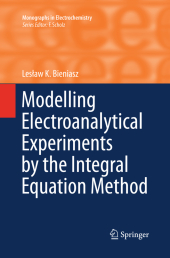 Neuerscheinungen 2016Stand: 2020-02-01 |
Schnellsuche
ISBN/Stichwort/Autor
|
Herderstraße 10
10625 Berlin
Tel.: 030 315 714 16
Fax 030 315 714 14
info@buchspektrum.de |

Leslaw K. Bieniasz
Modelling Electroanalytical Experiments by the Integral Equation Method
Softcover reprint of the original 1st ed. 2015. 2016. xvii, 406 S. 21 SW-Abb., 2 Farbabb., 2 Tabellen
Verlag/Jahr: SPRINGER, BERLIN; SPRINGER BERLIN HEIDELBERG 2016
ISBN: 3-662-51028-6 (3662510286)
Neue ISBN: 978-3-662-51028-5 (9783662510285)
Preis und Lieferzeit: Bitte klicken
This comprehensive presentation of the integral equation method as applied to electro-analytical experiments is suitable for electrochemists, mathematicians and industrial chemists. The discussion focuses on how integral equations can be derived for various kinds of electroanalytical models. The book begins with models independent of spatial coordinates, goes on to address models in one dimensional space geometry and ends with models dependent on two spatial coordinates. Bieniasz considers both semi-infinite and finite spatial domains as well as ways to deal with diffusion, convection, homogeneous reactions, adsorbed reactants and ohmic drops. Bieniasz also discusses mathematical characteristics of the integral equations in the wider context of integral equations known in mathematics. Part of the book is devoted to the solution methodology for the integral equations. As analytical solutions are rarely possible, attention is paid mostly to numerical methods and relevant software. This book includes examples taken from the literature and a thorough literature overview with emphasis on crucial aspects of the integral equation methodology.
Introduction.- Basic Assumptions and Equations of Electroanalytical Models.- Mathematical Preliminaries.- Models Independent of Spatial Coordinates.- Models Involving One-Dimensional Diffusion.- Models Involving One-Dimensional Convection-Diffusion.- Models Involving Two- and Three-Dimensional Diffusion.- Models Involving Transport Coupled with Homogeneous Reactions.- Models Involving Disturbed and Localised Species.- Models Involving Additional Complications.- Analytical Solution Methods.- Numerical Solution Methods.- Appendices.


